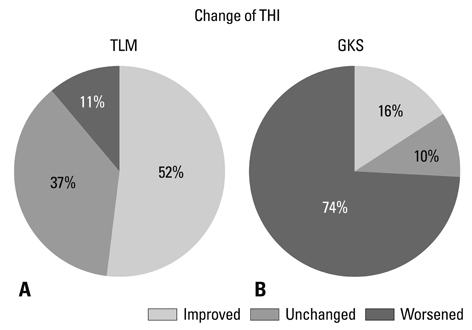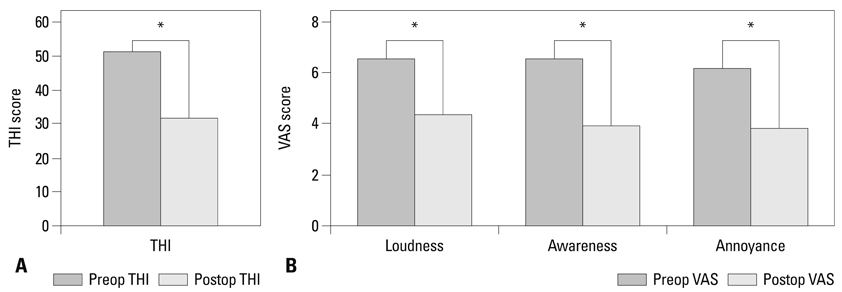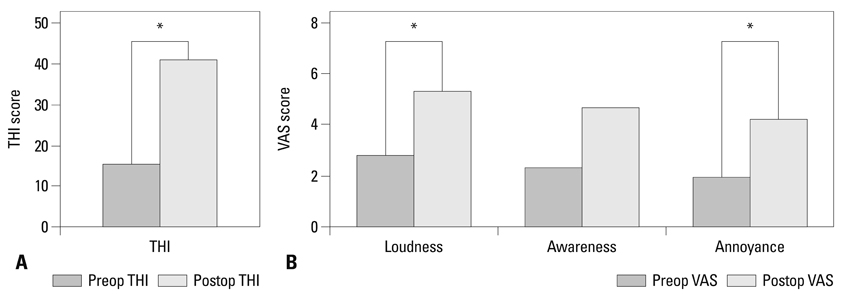Yonsei Med J.
2014 Jan;55(1):19-24. 10.3349/ymj.2014.55.1.19.
Change in Tinnitus after Treatment of Vestibular Schwannoma: Microsurgery vs. Gamma Knife Radiosurgery
- Affiliations
-
- 1Department of Otorhinolaryngology, Keimyung University College of Medicine, Daegu, Korea.
- 2Department of Otorhinolaryngology, Yonsei University College of Medicine, Seoul, Korea. ismoonmd@yuhs.ac
- 3Department of Otorhinolaryngology, Inje Univertigy College of Medicine, Ilsan Paik Hospital, Goyang, Korea.
- KMID: 1779881
- DOI: http://doi.org/10.3349/ymj.2014.55.1.19
Abstract
- PURPOSE
Tinnitus is a very common symptom of vestibular schwannoma, present in 45 to 80% of patients. We evaluated changes in tinnitus after translabyrinthine microsurgery (TLM) or gamma knife radiosurgery (GKS).
MATERIALS AND METHODS
Among 78 patients with vestibular schwannoma who underwent TLM or GKS at Severance Hospital from 2009-2012, 46 patients with pre- or postoperative tinnitus who agreed to participate were enrolled. Pure tone audiometry, tinnitus handicap inventory (THI), visual analogue scale (VAS) scores for loudness, awareness, and annoyance were measured before and after treatment. Changes of THI and VAS were analysed and compared according to treatment modality, tumour volume, and preoperative residual hearing.
RESULTS
In the TLM group (n=27), vestibulocochlear nerves were definitely cut. There was a higher rate of tinnitus improvement in TLM group (52%) than GKS group (16%, p=0.016). The GKS group had a significantly higher rate of tinnitus worsening (74%) than TLM group (11%, p<0.001). Mean scores of THI and VAS scores significantly decreased in the TLM group in contrast to significant increases in the GKS group. Tumor volume and preoperative hearing did not affect the changes in THI or VAS.
CONCLUSION
GKS can save vestibulocochlear nerve continuity but may damage the cochlea, cochlear nerve and can cause worsening tinnitus. In cases where hearing preservation is not intended, microsurgery with vestibulocochlear neurectomy during tumor removal can sometimes relieve or prevent tinnitus.
MeSH Terms
Figure
Reference
-
1. Propp JM, McCarthy BJ, Davis FG, Preston-Martin S. Descriptive epidemiology of vestibular schwannomas. Neuro Oncol. 2006; 8:1–11.2. Moffat DA, Baguley DM, Beynon GJ, Da Cruz M. Clinical acumen and vestibular schwannoma. Am J Otol. 1998; 19:82–87.3. Kentala E, Pyykkö I. Clinical picture of vestibular schwannoma. Auris Nasus Larynx. 2001; 28:15–22.
Article4. Haapaniemi J, Laurikainen E, Johansson R, Miettinen S, Varpula M. Cochleovestibular symptoms related to the site of vestibular schwannoma. Acta Otolaryngol Suppl. 2000; 543:14–16.
Article5. Møller AR. Pathophysiology of tinnitus. Ann Otol Rhinol Laryngol. 1984; 93(1 Pt 1):39–44.
Article6. Pulec JL, Hodell SF, Anthony PF. Tinnitus: diagnosis and treatment. Ann Otol Rhinol Laryngol. 1978; 87(6 Pt 1):821–833.
Article7. Shea JJ, Emmett JR, Orchik DJ, Mays K, Webb W. Medical treatment of tinnitus. Ann Otol Rhinol Laryngol. 1981; 90(6 Pt 1):601–609.
Article8. Hazell JW, Jastreboff PJ. Tinnitus. I: Auditory mechanisms: a model for tinnitus and hearing impairment. J Otolaryngol. 1990; 19:1–5.9. Pollack AG, Marymont MH, Kalapurakal JA, Kepka A, Sathiaseelan V, Chandler JP. Acute neurological complications following gamma knife surgery for vestibular schwannoma. Case report. J Neurosurg. 2005; 103:546–551.
Article10. Kameda K, Shono T, Hashiguchi K, Yoshida F, Sasaki T. Effect of tumor removal on tinnitus in patients with vestibular schwannoma. J Neurosurg. 2010; 112:152–157.
Article11. Schaller BJ, Rasper J, Filis A, Buchfelder M. Difference in functional outcome of ipsilateral tinnitus after intraoperative occurrence of the trigemino-cardiac reflex in surgery for vestibular schwannomas. Acta Neurochir (Wien). 2008; 150:157–160.
Article12. Haid C. Acoustic Tumor Surgery and Tinnitus. Int Tinnitus J. 1998; 4:155–158.13. Harcourt J, Thomsen J, Tos M. Translabyrinthine vestibular schwannoma surgery: postoperative tinnitus and cochlear nerve integrity. Auris Nasus Larynx. 1997; 24:21–26.
Article14. Silverstein H, Haberkamp T, Smouha E. The state of tinnitus after inner ear surgery. Otolaryngol Head Neck Surg. 1986; 95:438–441.
Article15. Myrseth E, Møller P, Pedersen PH, Lund-Johansen M. Vestibular schwannoma: surgery or gamma knife radiosurgery? A prospective, nonrandomized study. Neurosurgery. 2009; 64:654–661.16. Hempel JM, Hempel E, Wowra B, Schichor Ch, Muacevic A, Riederer A. Functional outcome after gamma knife treatment in vestibular schwannoma. Eur Arch Otorhinolaryngol. 2006; 263:714–718.
Article17. Bertalanffy A, Dietrich W, Aichholzer M, Brix R, Ertl A, Heimberger K, et al. Gamma knife radiosurgery of acoustic neurinomas. Acta Neurochir (Wien). 2001; 143:689–695.
Article18. Niranjan A, Lunsford LD, Flickinger JC, Maitz A, Kondziolka D. Dose reduction improves hearing preservation rates after intracanalicular acoustic tumor radiosurgery. Neurosurgery. 1999; 45:753–762.
Article19. Moller AR. Similarities between severe tinnitus and chronic pain. J Am Acad Audiol. 2000; 11:115–124.
Article20. Lockwood AH, Salvi RJ, Coad ML, Towsley ML, Wack DS, Murphy BW. The functional neuroanatomy of tinnitus: evidence for limbic system links and neural plasticity. Neurology. 1998; 50:114–120.21. Berliner KI, Shelton C, Hitselberger WE, Luxford WM. Acoustic tumors: effect of surgical removal on tinnitus. Am J Otol. 1992; 13:13–17.22. House JW, Brackmann DE. Tinnitus: surgical treatment. Ciba Found Symp. 1981; 85:204–216.
Article23. Jastreboff PJ, Hazell JW. A neurophysiological approach to tinnitus: clinical implications. Br J Audiol. 1993; 27:7–17.
Article24. Linskey ME, Johnstone PA, O'Leary M, Goetsch S. Radiation exposure of normal temporal bone structures during stereotactically guided gamma knife surgery for vestibular schwannomas. J Neurosurg. 2003; 98:800–806.
Article25. Kohno M, Shinogami M, Yoneyama H, Nagata O, Sora S, Sato H. Prognosis of Tinnitus After Acoustic Neuroma Surgery-Surgical Management of Postoperative Tinnitus. World Neurosurg. 2012.
Article26. Baguley DM, Humphriss RL, Axon PR, Moffat DA. The clinical characteristics of tinnitus in patients with vestibular schwannoma. Skull Base. 2006; 16:49–58.
Article27. Kanzaki J, Satoh A, Kunihiro T. Does hearing preservation surgery for acoustic neuromas affect tinnitus? Skull Base Surg. 1999; 9:169–176.
Article
- Full Text Links
- Actions
-
Cited
- CITED
-
- Close
- Share
- Similar articles
-
- Normal pressure hydrocephalus after gamma knife radiosurgery in a patient with vestibular schwannoma
- Hearing Preservation, Facial Nerve Dysfunction, and Tumor Control in Small Vestibular Schwannoma: A Systematic Review of Gamma Knife Radiosurgery Versus Microsurgery
- Gamma Knife Radiosurgery for Vestibular Schwannomas
- Gamma-Knife Radiosurgery for Vestibular Schwannoma
- Clinical Experience of Gamma Knife Rediosurgery for Acoustic Neurinomas





